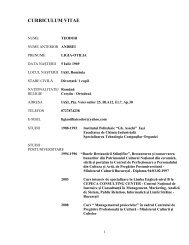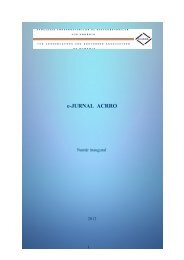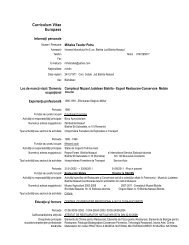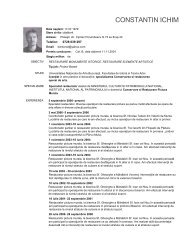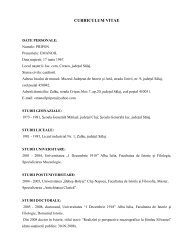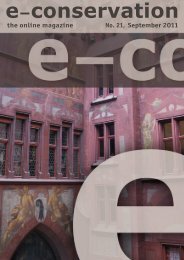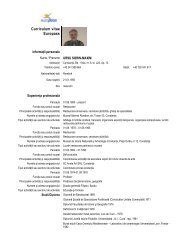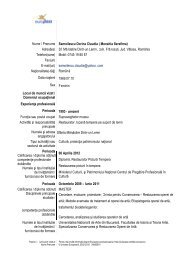e-conservation the online Magazine 16, oct 2010.pdf
e-conservation the online Magazine 16, oct 2010.pdf
e-conservation the online Magazine 16, oct 2010.pdf
You also want an ePaper? Increase the reach of your titles
YUMPU automatically turns print PDFs into web optimized ePapers that Google loves.
IDENTIFICATION OF IVORY BOOK COVERS<br />
varnish applied over <strong>the</strong> ivory, distracting from <strong>the</strong><br />
natural beauty of <strong>the</strong> underlying ivory. Acetone<br />
swab could be used to remove varnish, however it<br />
is likely too risky to attempt removal of <strong>the</strong> varnish<br />
as <strong>the</strong> ivory is inset into <strong>the</strong> metal frames<br />
(Figure 13).<br />
Warping<br />
The removal of backings from portrait miniatures<br />
often reduces <strong>the</strong> pressure that is causing <strong>the</strong>m<br />
to warp [24]. Miniatures are placed face down<br />
and a thin scalpel blade is used to peel away <strong>the</strong><br />
backing, ensuring it is secure on a curved support.<br />
Adhesives may require softening with a damp blotter<br />
[23], less than 50% ethanol in water [20], or<br />
10% Laponite solution through a tissue [23]. In<br />
miniatures, <strong>the</strong> backing cards are an addition to<br />
facilitate painting of <strong>the</strong> ivory. In books, <strong>the</strong> backings<br />
are <strong>the</strong> book board, an integral part of <strong>the</strong><br />
structure and intention of <strong>the</strong> object. Thus despite<br />
warping, it is not advisable to remove <strong>the</strong><br />
ivory from <strong>the</strong> card, nor reline <strong>the</strong> ivory.<br />
The warping of ivory is a serious issue for portrait<br />
miniatures as it affects <strong>the</strong> delicate paint layer and<br />
may escalate until <strong>the</strong> ivory exceed <strong>the</strong> dimensions<br />
of its case [22]. Ivory pieces can be placed in a<br />
chamber conditioned with silica gel at 65-70%<br />
RH for 10 minutes up to 2-5 hours, <strong>the</strong>n clamped<br />
between Plexiglas ® sheets [23]. This successfully<br />
relaxes ivory to a more flattened state.<br />
In addition, a Gore-Tex ® humidifying system has<br />
been adapted from paper <strong>conservation</strong> to flatten<br />
miniatures on ivory [24]. The miniature is placed<br />
concave side down, between layers of Gore-Tex ® ,<br />
silicon paper, blotting paper, and plastic [25]. Gore-<br />
Tex ® allows a controlled amount of moisture to<br />
pass through <strong>the</strong> ivory, and if necessary, increased<br />
weighting will gradually flatten <strong>the</strong> ivory in 4-8<br />
hours [26].<br />
Though <strong>the</strong> silica gel and Gore-Tex ® methods do<br />
reduce irregular distortions, it is often not possible<br />
or wise to attempt to completely flatten <strong>the</strong><br />
miniature [24]. A safe alternative to attempting<br />
to force <strong>the</strong> ivory flat is simply to accept some<br />
distortion [24]. In fact, specialized sink mats can<br />
be made with 2-ply rag board [23] or Plastazone,<br />
which allow responses to changes in environment<br />
from <strong>the</strong> portrait miniatures [24].<br />
Though <strong>the</strong>re is a significant warp in <strong>the</strong> ivory of<br />
<strong>the</strong>se books, flattening treatment is not recommended.<br />
There are too many mixed materials in<br />
<strong>the</strong> books to attempt flattening. Each of <strong>the</strong>se<br />
materials would respond differently to <strong>the</strong> moisture<br />
introduced in flattening treatments. Fur<strong>the</strong>rmore,<br />
Book 1 and Book 2 exhibit natural curving<br />
which do not conform to <strong>the</strong> text block, nor should<br />
it be forced. Book 3 shows restrained buckling<br />
that is caused by various pressures exerted from<br />
<strong>the</strong> metal framing, adhesive and varnish. If <strong>the</strong>se<br />
pieces were detached, <strong>the</strong>y would benefit from a<br />
relaxing treatment from ei<strong>the</strong>r silica gel chamber<br />
or a Gore-Tex® procedure.<br />
Cracking<br />
Ivory cracks and losses are <strong>the</strong> result of former<br />
stresses and distortions, meaning pieces may not<br />
align and will be difficult to successfully repair<br />
[19]. Thus, <strong>the</strong>y should be treated in <strong>the</strong> early<br />
stages as soon as possible to avoid increased damage<br />
[24]. Unfortunately, very extreme warping<br />
and cracking of ivory is essentially irreversible [3].<br />
Prior to treatment of ivory cracks, individual pieces<br />
must be flattened first [20], with <strong>the</strong> backing paper<br />
removed [24].<br />
Experimentation to find <strong>the</strong> ideal adhesive for<br />
treating ivory resulted in nearly every material<br />
being used in <strong>the</strong> past [27]. Mowilith DMC2 is<br />
currently recommended based on CCI test results,<br />
e-<strong>conservation</strong><br />
35



